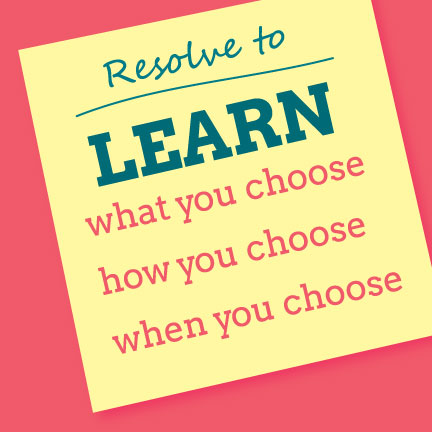Month: February 2016
Learning For The Fun Of It

(We like this idea so much we’re repeating it for all the students who may need a reminder that learning can be fun!)
Though we here at Meemli don’t like to admit it, sometimes, learning can feel like a chore. Being assigned to memorize the Prologue to “The Canterbury Tales” or repeatedly writing the conjugations for irregular AR verbs for Spanish class could feel mind-numbing. To make it worse, most of the time, you’re not learning for the fun of it, you’re doing it because you have to – grades, college admissions and everything else demands it.
Surprisingly, when schoolwork gets to be a drag, more learning might put the zing back in it – as long as you’re learning something just because.
Learn what you choose, how you choose, when you choose.
Choose to Learn

What does that mean? How do you go about doing it?
Here’s how:
Pick something just for you.
That means learn something for fun, not because you have to. Pursue something you’ve always found interesting. You can choose to learn to play just one song on the guitar, or learn to be really good at it. Practice 25 common Russian phrases just because your grandfather was born in Russia. Love to cook? Well, you can learn about the science of baking.You can learn anything: a language, a subject you don’t have at school, a sport, music, pottery. Anything at all. Your choice. Choose whatever subject you find fascinating, and dig a little deeper.
Choose how you will learn.
Maybe you want to sign up for a class, or maybe you don’t. There’s a YouTube video for practically every learning need, from quilting to quantum physics! As you probably know, there are tons of ways to learn something new. Read a book, take an online course, talk to other people, or find a mentor. There might be local clubs that you could consider joining if you want to learn with others. Sometimes the best way to learn something is to ask an expert – Grandpa would probably be more than happy to teach you those 25 Russian phrases!
Make up your own schedule/timeline.
Since you’re learning this new subject because you want to, you also get to set the schedule. You could choose to spend one day on this project over a weekend or spring break, or 30 minutes every week for several weeks. You can think short-term, or plan a schedule over the next year or two. It’s your time and your goal, so do whatever works best for you and your schedule. And, since this learning isn’t something you have to do, you never have to feel pressured. Stuff happens and plans change. Extend your timeline whenever you need to, with no qualms.

Still need convincing? Here’s why you should try learning just for the fun of it:
1. Boost your brain.
Learning new things actually changes your brain – in a good way. (Read the science behind learning here.) There’s been a fair amount of research that is finding a link between learning a new skill (even something like quilting) to improved memory. So, stretch your brain to stay sharp, for now and for when you take the inevitable SATs, ACTs, entrance exams and the like. Great minds think – period!
2. Feel good.
Accomplishing a task makes us feel fulfilled, satisfied and self-confident, especially if it’s something you’ve wanted to do for a while. So choose something you enjoy, or something you’ve always wanted to do. You’re a learner, choosing to know and do something that’s of meaning to you. There’s a sense of fulfillment that comes when you immerse yourself in something that interests you. Since you’re in control of your learning and it’s free from external pressures, you can work on learning your new skill without stress, guilt, deadlines or dread (the perception of being in control is another stress-reducer).
4. Impress the grown-ups.
Taking on a new learning goal just because you want to is impressive. It demonstrates motivation, dedication, and initiative — all qualities that adults like to see in teens (and, anyone else for that matter). Not only will you impress the grown-ups around you, this will add a big boost to your resume when applying for colleges and future jobs too.
5. Make yourself more interesting.
Ok, this may not be THE reason to learn, but it certainly gives you a fun conversation starter next time you’re waiting in the lunch line or trying to impress that new boy or girl at your school. You don’t have to limit yourself to classwork, the upcoming Sadie Hawkins dance, or the new substitute teacher – you now have something new and different to share. Those 25 Russian phrases you’re working on may come in handy!
It’s easy to see why learning something for the fun of it is a no-lose proposition. We’d love to hear your thoughts. What have you always wanted to learn? Let us know!
26 Feb, 2016
Teens Worth Watching

Yawn. A dreary winter day? Everything seems like the same-old, same-old, you have too much work to do and spring break is far away? Looking to get re-energized and wondering how to do and be more? This post should help! We have collected Ted and TedX talks by some teens worth watching. They will give a metaphorical caffeine-jolt to your system and make you think “Wow! Maybe I can do something like that” – even if you’re not a teen.
Grab some popcorn and learn something new from these can-do kids!

Image courtesy Idea Go at FreeDigitalPhotos.net
Breaking the Procrastination Habit
Vik Nithy started 3 companies by the time he was 20, and he says he was a procrastinator! Okay, Vik was a procrastinator. He talks about how our monkey brain makes us put things off and how we can overcome that habit. (He also shows how to present without being flustered by technical difficulties – another inspiration!)
Role Models
Tavi Gavinson is a teen looking for a strong female role model, who built a website to help others like her and is on her way to becoming one herself!
Breaking the Language Barrier
Struggling with your “foreign” language requirement? This teen learned to speak over 20 languages using his own unique process. There’s a lot you can learn from Tim Doner!
A Win-Win Approach
How would you handle a lion in your backyard? If you’re Richard Turere, this is what you’d do – without resorting to extreme measures.
We hope you enjoyed these videos as much as we did. Have your own favorite inspirational video? Tell us about it!
19 Feb, 2016
College Tours: Tips For Teens

Already dreaming of the day you’d be going to college? Good for you! Of course you have to finish high school, get good grades, do SATs/ACTs etc., but wanting to be in college is an important first step. Another helpful step in making it real is visiting colleges. Touring campuses will help you get familiar with the process and figure out what will work best for you. Also, visiting colleges will make going to college less scary! With Spring Break coming up, our “College Tours: Tips for Teens” will get you started on planning this major road trip.
When’s a good time to start college tours? The short answer: early! When I was teaching a college preparation course, I took freshmen and sophomores on college field trips just as frequently as the juniors and seniors. I found it helped to visit schools early to get a sense of what you are looking for. This way, when application season rolls around, you don’t feel rushed in your choices.
Now, while you may be ready to go, you need to to get your parents to agree too. You can start by sharing our post written for parents on the importance of college tours and how to plan for them. If your parents need more convincing, try these options.
Show you are serious.
You’ve already shown an interest in higher education, so you are off to a great start. Before talking to your parents, figure out what schools are the most appealing and why. Do some initial research to show that you are serious and this is important to you. (Your school counselors may be a helpful resource too.) Your parents may be swayed by your taking the initiative.
Be reasonable.
College visit expenses can add up quickly once you factor in transportation, hotel, and meal costs, so be reasonable about your expectations. You won’t be able to visit every school on your list, so start with the one you like the most and then schedule tours at several colleges that are within driving distance from one another. If you present a thoughtful, realistic itinerary, your parents will be more likely to agree to it.
Keep an open mind.
Maybe your parents insist you visit their alma mater, or what they think is the perfect school for you. Don’t fight it. Stand firm in your choices, after all, you are the one going to college, but be open to looking at a place you might not have considered – you may learn what you don’t want, which can be as important as knowing what you do want. And, you never know, you just might like a school your parents suggested!
Got your parents on board? Once you get to the campus, it’s up to you to make the most of your visit.

Know what to expect.
Visits can range from an hour-long guided tour to an overnight stay in a dorm (offered by some colleges). On the guided tour, a student admissions officer will show you the library, the student union, the bookstore, and the academic buildings where you’d take classes. You’ll also probably check out interesting focal points around campus, such as a famous statue or a lucky fountain.
Ask questions.
Visiting schools allows you to have meaningful conversations with students and staff members who can share information on what’s important to you. You can easily find out how many students attend the school, but what are the most popular student hang-outs? Here’s a helpful list of questions you can ask. And remember, this visit is for you, so ask your own questions; don’t let your parents do the talking for you.
Take notes.
I know, it sounds like an assignment, but you’ll be glad you did it. When visiting several schools back to back, information tends to blend together, and no matter how many times you tell yourself you’ll remember, odds are, you won’t. Make life easier by jotting down a few things that stand out so that you can reflect later. And of course, take pictures, too!
Observe.
Find a bench in the middle of campus, and soak it all in. Can you imagine yourself walking to class everyday? Do the students smile or say hi to you as they pass? What do you notice about how people interact with one another? I’d also recommend looking around the surrounding area. Since you’ll be spending at least four years at this school, it’s important that you like what the location offers. Is there a lively downtown nearby or hiking trails? These things will matter when you desperately need a study break and want to get off campus for a bit.
Break free.
At some point, try to wander around the campus on your own, without guides or parents. Guides and admissions representatives are experts at highlighting the best parts of the university, but you won’t get the complete picture. To form your own opinions, venture out on your own. Here are tips to get a good feel for the campus by exploring on your own without the additional commentary from parents.
Searching for the right college is an adventure. Be mindful of how you feel on each campus, but don’t worry if there’s no magical moment when you just know. Sometimes it takes a while to figure out, and that’s okay. Take time to reflect and enjoy the process. Lastly, remember it is an exciting and scary time for parents as well, so a warm thank you and hug will be a perfect ending to your college tour.
So tell us, what colleges are you looking forward to visiting?
11 Feb, 2016
College Tours: A Short Guide For Parents

Check out our companion post “College Tours: Tips for Teens” !
During school breaks, families get busy planning on how to spend the precious time together. If you have a teen in high-school a trip to visit colleges might be just the thing and it is never too early. College tours offer both you and your child an opportunity to start thinking about and planning for college application time – which will show up sooner than you think! Your child will learn about what to look for when deciding where to apply, and it might guide her activities and choices in school. Meanwhile, you will learn about the admissions process, the financial impact and how to figure out the best fit for your child and your family. When I was counseling high school students, I found that a visit invariably had a huge impact. When asked why visiting a college is important, college junior Alyssa said, “There is a totally different feeling when you go from campus to campus. And I had the best feeling at Baldwin Wallace. You just sort of know.” Plus, it can be a lot of fun exploring new places together. So, pack up and hit the road! Here’s how to get started.
Talk it out.
The purpose of college visits is to help your child figure out which school is the best match, so plan together. Arranging to visit your dream colleges may seem like a great idea, but ultimately, it’s important for your child to have some say in the process. Your trip will be a lot more successful if you are able to approach it in a positive, collaborative way. Do this by starting a dialogue, asking questions, and keeping an open mind.
Create a budget.
Your budget will determine what you can do. Are you able to fly across the country, or does a road trip seem more feasible? Can you get away for a week, or just a few days? Campus tours are free, but you need to account for meals, lodging, and transportation. (Don’t forget to add in the extra cost of buying a souvenir shirt or key chain!) Check out this article for some money saving tips.
Choose a region.
You probably won’t be able to visit campuses in both California and New York, so discuss which state is most appealing, then narrow it down to a region with several possibilities. Choose schools that offer different experiences: large and small campuses, a school in the city, and one in a rural town. If you are limited, consider visiting local universities, including community colleges. The goal is to get a feel for the type of school that is most suitable. Often, you won’t know what’s right until you get there.
Consider the type of visit.
Guided Tour
This is the most common type of tour and is typically led by a student admissions officer. You will see the main parts of campus, hear about the school’s history, and learn about academics and activities.
Self-Guided Tour
If you prefer to venture out on your own, the self-guided tour provides a lot of freedom. You can access information on your mobile device, listen to an audio tour on your cell phone, or wander around with a detailed map. Take a look at all these options at University of California, Berkeley!
Overnight Visit
Not all universities offer overnight stays, but if you can find a way for your child to participate in one, take advantage. Seeing a campus at all times of day, meeting a variety of college students, and sleeping in a dorm is a fantastic experience.
Reserve your spot.
You’d be surprised how quickly tour spots fill up, so make your reservations about four weeks in advance. Call the Admissions Office to see what’s available. You can also book a reservation through the school’s website. If you are unable to schedule a formal tour, plan to visit the campus anyway and do a self-guided tour. Check the school’s calendar to make sure classes are in session. You will want to see students milling about campus and have access to staff members who can answer questions.
Make a plan.
Visit two schools per day, spending about three hours at each. Factor in drive time and meal stops, and you have a full agenda! Even touring a small campus can be exhausting, so don’t overwhelm yourselves. Also, save time and frustration by calling ahead to find out where to park. You don’t want to waste time running to feed a meter every hour or risk getting a ticket because you don’t have the proper permit.
Alternative option.
Can’t get away? No problem! You can visit almost anywhere from the comforts of your home. And for free, too!
Take a virtual tour.
Most colleges post videos on their websites. They won’t provide a comprehensive view, but it’s a great starting place. Some schools also have their own YouTube channel with additional videos. Another resource is CollegeWeekLive, which is a virtual college fair. Create a free account to watch presentations and chat live with admissions officers and students.
Talk to students.
Call the admissions office and request a time to chat on the phone with a student representative. After watching videos and researching all the fun facts about the school, it’s still helpful to talk to students who attend the school and can address specific concerns. The admissions office is eager to help and should be happy to set this up for you.
Final thoughts.
Prepare in advance, don’t feel pressure to see every college on the list, and do your research. Most importantly, remember this trip is about your child, not about you – so share your opinions, but let him form his own. For more tips on how to make the most of your college visit, read this parent’s post. And of course, have fun – college trips are often unforgettable, so make sure the memories are good ones!
What advice do you have for parents who are planning a college visit? We’d love to hear from you.




